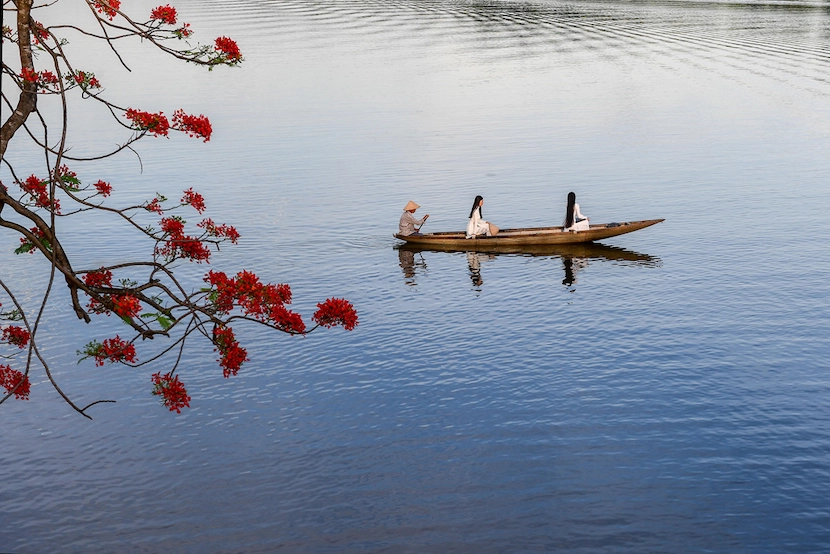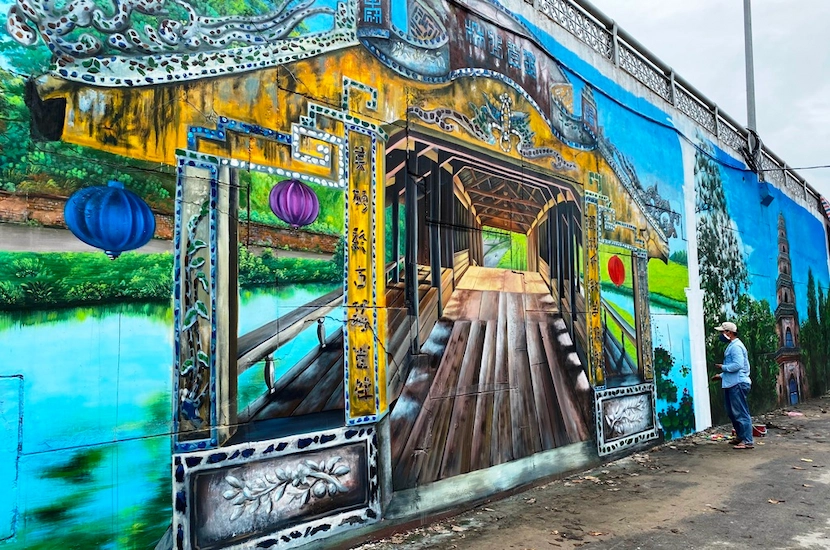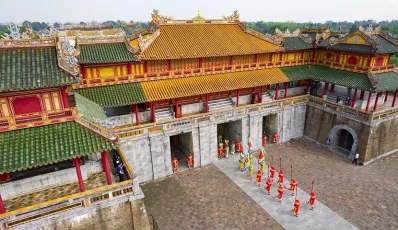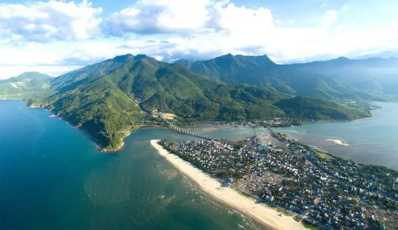The Perfume River is a great river that flows through the heart of Hue City, famous for its poetic and lyrical beauty. It is not merely the source of water but also the pride of the ancient capital. According to historical documents, it had many different names through time, such as the Linh River, Lo Dung River, Dinh River, and Yen Luc River, before being officially named the Perfume River.
1. The legend of the Perfume River

The people of Hue have several stories to explain why the river is called the Song Huong (the Perfume River). Some people said that when they walked upstream, they discovered an herb named Thach Xuong Bo, which gave fragrant flowers that mixed with the river water. Besides, there is a famous legend about Thanh Trung village, which is renowned for growing herbs in Hue. Because of villagers' love for the beautiful river, villagers on both sides of the river cooked water mixed with hundreds of sweet-scented flowers and poured it into the river to make the blue water aromatic forever.
2. Where does the Perfume River originate from?

The Perfume River has two main sources (Ta Trach and Huu Trach), both of which start from the Truong Son range and flow into one at the Bang Lang junction. The stretch from Bang Lang to the sea is 33 km long. The Perfume River flows through Hue City and other districts such as Huong Tra, Huong Thuy, and Phu Vang of Thua Thien Hue Province. The interesting fact is that wherever the Perfume River flows, villages are formed, and gardens are abundant. Therefore, the river is a symbol of a sacred living source and spirituality of Hue's people.
3. Characteristics of the Perfume River
The river flows through the heart of Hue city
There are few rivers that cross big cities in Vietnam, however the Perfume River is such a river. The beauty of the Perfume River reflects the Hue ancient city's culture that has experienced many ups and downs but is also very mysterious and fascinating.
The inspiration for many poets
Along with the long history, the Perfume River has also the main object in poetry and music. From Hue folk songs to poems, Perfume River makes both the writers' and listeners' souls touched. You can enjoy the music about Perfume River if joining a boat trip combined with live music.
The river of festivals
It is not an exaggeration to call the Perfume River a river of festivals because it has become the venue for many festivals associated with the culture of the ancient capital. When visiting Hue's ancient capital, you can see the calendar in advance to join the Lantern Festival, the Hon Chen Festival, the Traditional Boat Racing Festival, the Hue Festivals, etc.
4. Bridges over the Perfume River
The Perfume River is famous for 6 bridges, including the Truong Tien Bridge, Phu Xuan Bridge, Da Vien Bridge, Kim Long Bridge, Dap Da Bridge, and Cho Dinh Bridge. Each of these has its own characteristics. During your Hue city tour, you will cross at least two beautiful bridges, so let's see what is special about them.
Truong Tien Bridge

Truong Tien Bridge is 402.6m long, consisting of 6 spans of comb-shaped steel girders, each of which is 67m long and 6m wide. The bridge is designed in Gothic architecture, crossing the Perfume River. The northern part of the bridge starts from in Dong Ba district, while the southern part is in Phu Hoi district in Hue city center. This is the most famous bridge over the Perfume River and has inspired many poetry, music, and painting. Truong Tien Bridge has become a must-see destination for those who have the opportunity to visit Hue.
Phu Xuan Bridge

Phu Xuan Bridge was built in 1970, designed and organized by the French firm Eiffel. After 2 years of construction, it was completed and put into operation. The bridge is 374.65m long, 17m wide, with the loading capacity of the bridge is 18 tons. Both sides of the bridge have sidewalks for pedestrians, and railings are built to ensure the safety of vehicles in traffic. From 1971 till now, the Phu Xuan Bridge has been renovated twice, in 1998 and 2009. When its construction was just finished (1971), the bridge was named Cau Song Huong (The Perfume River Bridge). After 1975, it was renamed as Phu Xuan Bridge by the government.
Da Vien Bridge

Da Vien Bridge, crossing the Perfume River, connects Le Duan Street to Bui Thi Xuan Street. In 1908, when the iron bridge crossing the Perfume River to connect the north-south railway was built, it was named Da Vien Bridge. Because the central part of the railway section here was built right on the terrain of Da Vien islet. However, the northern part of this bridge is too close to the old Bach Ho Bridge (now called Kim Long Bridge), people in Hue often mistakenly call it Bach Ho Bridge.
In 2010, this bridge was rebuilt and there was widespread consultation among people about the name of the bridge. In 2012, the People's Council of Thua Thien Hue Province voted to approve the name of the road bridge over the Perfume River as Da Vien Bridge.
Dap Da Bridge
The Dap Da Bridge was built in 1917 during the French colonial period. At that time, the Dap Da bridge played an important role in the traffic, linking Vy Da with Hue City, preventing saltwater intrusion into the Perfume River in summer by preventing water upstream of the Perfume River from spilling over during the rainy season to limit flooding. The Dap Da bridge now is located between Le Loi (Phu Hoi ward) and Nguyen Sinh Cung (Vy Da ward, Hue city).
Cho Dinh Bridge

Cho Dinh Bridge was built in 2000 in the north of Hue city, connecting Phu Thuong district with Phu Hau district. Its special feature is the giant wall painting at its foot. The paintings depict many typical Hue attractions: the Phu Dien Cham Tower, Thuan An beach, Thanh Toan Bridge, Thien Mu pagoda… From the late 2020s until now, the foot of Cho Dinh Bridge has become an interesting landmark for Hue travelers.
Go Lim Bridge

Go Lim Bridge is a pedestrian bridge in Hue. It is 4m wide, located on the bank of the Perfume River. Being made of ironwood, the bridge covers 2,443 m2, paved with 5cm thick wood. The total cost of the project is nearly VND 53 billion. The vast, airy space of the bridge is suitable for fun and ideal walks for everyone. From here, visitors can watch the breathtakingly beautiful sunset in this poetic city.
Ban Nguyet Bridge

The Ban Nguyet bridge was built in the Ben Me area, Phu Thuan district, on the north bank of the Perfume River. Like its name, the bridge is a semicircle with no railing. Possessing a "no blind spot" viewpoint, together with Vong Canh Hill, the Ban Nguyet Bridge in Hue is the most beautiful place to take photos and watch the sunset in Hue so far.
The beauty of the Perfume River has inspired many artistic works, but only when you experience it yourself can you fully feel the poetic and imaginative beauty of this river. The Perfume River and its bridges are always a must-visit destination for tourists coming to Hue City.
If you have any further questions, feel free to leave a comment below, or contact us via email: [email protected] or WhatsApp: +84 382 536 266 for instant assistance.
See more:






















 TRAVELERS' CHOICE 2025
TRAVELERS' CHOICE 2025 


